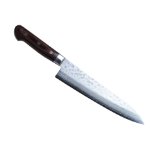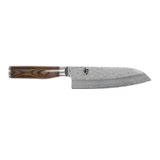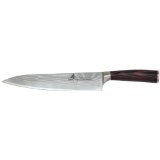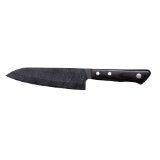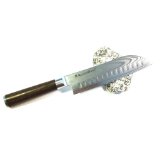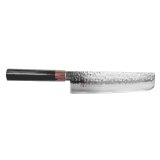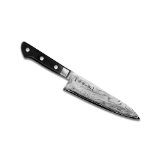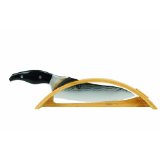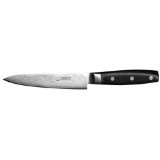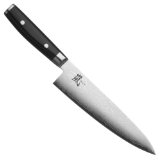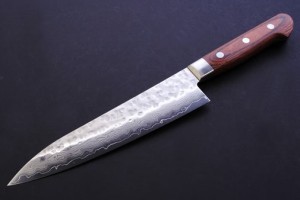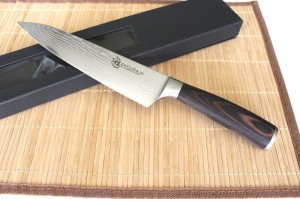What are the Best Damascus Steel Knives?
You’ve got to admit that Damascus Steel Knives look absolutely beautiful compared to your normal regular stainless steel kitchen knife. Each Damascus steel knife is truly unique and there are not two Damascus knives that look the same as every piece of Damascus steel is as unique as a finger print.
Since this steel manufacturing process has been rediscovered there has been a sudden trend in handmade Damascus steel kitchen knives with many professional chefs as well as collectors buying these knives for their collection.
However like all styles of kitchen knives the Damascus knives have their pros and cons below we have put tighter a guide to give you a little help when choosing to buy a Damascus style kitchen knife.
Damascus Steel Knives Buying Guide
Brief History of Damascus Steel
The ancient process of producing Damascus steel knives has been “rediscovered” as it had been a lost manufacturing technology from the early 1700’s up until World War II. In the 1970’s is when this steel process gained popularity.
The original traditional Damascus steel was first manufactured over two thousand years ago and can be traced back to around 500 A.D. In India back then this type of steel was referred to as Wootz, Telangana, or Ukku steel. From ancient India it found its way to Damascus in Syria which was a trade center for war equipment such as knives, swords and armor and was termed as Pattern Weld, Damast, and Damascene.
Damascus styled knives and swords were the best of the best in the weapon industry from the Iron Age to through to the Viking age. Even Alexander the Great is said to have used a Damascus sword, and even Aristotle talked about the high quality of the Damascus steel blade.
Today Damascus steel is known as the steel of the ancients and can be found in many modern kitchens in the form of stylish kitchen knives.
How Do They Make Damascus Steel Knives
How Damascus steel is made is actually a tiresome process that involves a combination of low and high carbon steels. The two steel varieties are folded and forged welded together; this technique is repeated over and over again until a large number of combined layers have been made. The finished blade is then etched to bring out the beautiful metal grain and detailed pattern that has been produced.
The end product is a extraordinary tough and also flexible blade that has excellent edge retention. The edge of a Damascus blade contains tiny saw-tooth carbides which enables the knife blade to cut even if it’s dull to the touch.
Damascus Steel Knives My Top Picks
Yoshihiro Cutlery Hammered Damascus Gyuto Knife
The Yoshihiro Damascus knife looks great and has been made with 16 layers of hammered Damascus Japanese super steel VG-10 using traditional knife making techniques to produce as one of a kind kitchen knife.
This Damascus knife is an exceptional kitchen knife for anyone looking for an introduction to fine Japanese knives. The blade is wafer thin and razor sharp and the attached mahoganyy handle finished the knife off completely, giving it an antique traditional look and feel.
It is extremely sharp out of the box and is much sharper than the typical high end western knives like Henckels or Wusthof knives.
The combination of VG-10 steel and the hammered Damascus finish may make it a little harder to maintain and sharpen don’t let that put you off as this knife hold a razr sharp edge for a long time.
This knife will become your new go-to kitchen knife!
Shun Premier Santoku Knife
We have review and featured this knife in the past and it is still one of our all time favorite knives, if you have the budget to spend we recommend investing in this Shun knife, and believe us you won’t be disappointed.
This Shun Damascus knife has been styled on the classic Japanese chef’s knife and is ideal for everyday food prep like; chopping , cubing, slicing, dicing, and much more. Its wide blade also makes it possible to scoop cut pieces and transfer them from the cutting board to awaiting pots or bowls.
As we have mentioned before this Shun knife has been produced using the same ancient techniques that were used to manufacture samurai swords.
The knife blade features a VG10 steel blade that is clad with 32 layers of high quality stainless Damascus steel. Each of the blades have a hand-hammered finish that is not only visually appealing but functional as it creates a surface which reduces knife-drag when cutting and prevents food from sticking to the blade, which reduces knife-drag when cutting.
The handle of this shun knife is the favorite part for me is made from a premium Pakkawood with a walnut finish, it looks great and offers a secure comfortable grip
ZHEN Japanese VG-10 Damascus Dragon Gyuto Chef Knife
At our number three position is the ZHEN Japanese VG-10 Damascus knife, this knife features a 67 layer Damscus dragon pattern on both sides. They say that this design “could” increase the overall toughness, improve stain and rust resistance, hoe much of that is true we just don’t know but it does look great.
You only have to pick this chef’s knife up to see that the balance is exceptional and it feel perfect in your hand, if you have a lot of food prep to do I’m confident you could hack, slice, and dice away for any hours without any hand fatigue kicking in – it really is a dream to hold.
The handle is as desirable as the above two and comes in a durable non-slip hard Pakkawood that is bacteria resistant and comfortable.
Each of the ZHEN Damascus knives comes with a hand crafted presentation box which makes this Damascus knife a perfect gift for the chef in the family.

